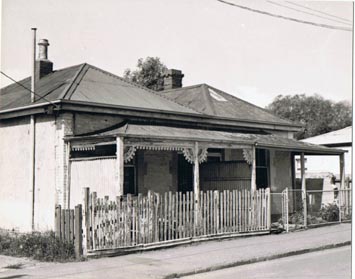
STREET SCENE COTTAGES
Brompton was established as a mixture of factories and workers’ cottages. The cottages pictured are typical of the small terraced cottages that were prevalent during the 1920s and 1930s.
| HALF DAYS AND PATCHED PANTS BOWDEN AND BROMPTON STREETS The streets of Bowden and Brompton were narrow when Siddy Fred and Mike were boys. There was barely room for two cars or horses and traps to pass one another, and most houses only had very narrow verandahs, and front bedrooms were only a few feet back from the footpaths. You could, as Siddy very often did, look into residents’ front bedrooms. Only a few people could afford motor cars but many rode bikes to the shops on the Port Road. Elderly people and those who found it difficult to walk relied on a service which no longer exists in modern suburbs provided by tradesmen who called on houses, took orders and then delivered them the same day. If you needed milk you put out a billycan with the money on the lid. The milkman called early in the morning and filled the billycan. The baker called in his horse and cart and delivered bread; the greengrocer called with fruit and vegetables; the rabbit-o called with freshly skinned rabbits; the iceman delivered blocks of ice for icechests, and hawkers called selling everything from packets of pins to secondhand shoes. It was possible for some to live without visiting shops as we do today. But there were corner stores, a butcher shop on one corner, a greengrocer on another and often lollyshops, as kids called them, on the fourth corner. Horses pulling carts and drays plodded up and down the streets but gradually motor cars took the place of horsepower and the shape and movement in suburban streets changed. T-model Fords were among the early cars in Adelaide in the 1930s.
|
 STREET SCENE COTTAGES Brompton was established as a mixture of factories and workers’ cottages. The cottages pictured are typical of the small terraced cottages that were prevalent during the 1920s and 1930s. |
|
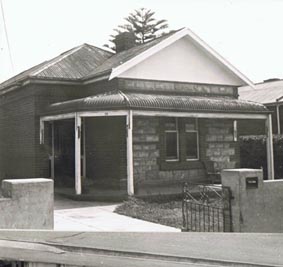 |
28 WEST STREET BROMPTON, the birthplace of the author and setting for the book Half Days and Patched Pants. His house was directly opposite the pughole. The house still stands in its original condition.
|
||
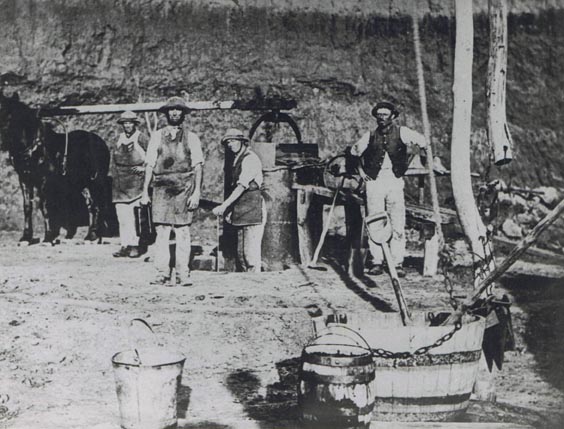 |
|||
|
PUGHOLE Pictured are workers in a pughole similar to the one operating in West Street Brompton during the years of the 1920s. It was directly opposite 28 West Street, Max Colwell’s boyhood home.
|
 |
 |
| Two of the principal characters of Half Days and Patched Pants were Mike’s grandparents. Max Colwell lived with his paternal grandparents in Brompton. They were the inspiration for those characters. Pictured here is Henry Colwell (Pup), and Mary Colwell. Pup was afflicted with a club foot, the result of an accident with a horse and carriage. He started work in the pughole at nine years of age and was illiterate for his entire life. | ||
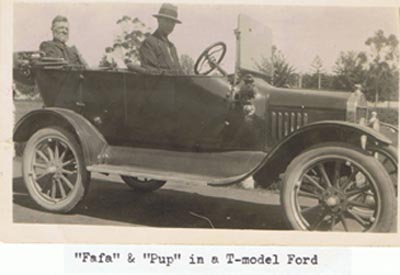 PUP IN CAR Max Colwell’s father, Len Colwell, in the driver’s seat of a T-model Ford with Pup in the back seat. |
|
||
 |
MISS JAM’S HOUSE At the time of this photo (1983) Miss Jam’s house still stood adjacent to the old pughole site, derelict and vacant. During the depression she lived alone in the house within ten feet from the edge of the pughole. The local kids considered her a witch, often tormenting her. Sadly, her house was demolished in 1985 to make way for new housing.
|
||
 SCHOOL
Grade
Lower Two at the Hindmarsh Infants School in 1934. The classes were
mixed in the Infants School, and for this photograph children were asked
especially to wear shoes and socks. But quite often during the summer
months students came in bare feet. |
|
||
 THE BUMMER’S REST, now demolished, stood in the centre of the lawns between the up and down tracks of the Adelaide to Port Adelaide Road opposite West Street Brompton. It was the meeting place for the old blokes of Hindmarsh Bowden and Brompton and their dogs. Its circular construction looked quaint and inviting but it wasn’t always a peaceful place, especially when religion and politics came up for discussion amongst its inhabitants. Mike’s grandfather and Taffy Carroll, who were regular Bummer’s Rest residents, never actually came to blows when they were arguing the point but they did wave their sticks around and spit on each other’s boots. Siddy, Fred and Mike spent a lot of time listening and laughing at the old blokes on their way home after school. |
|
||
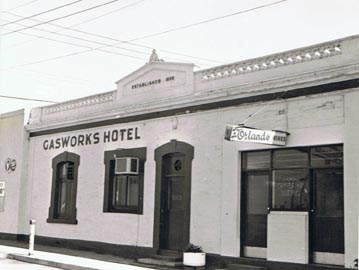 |
THE GASWORKS HOTEL in Brompton featured in Half Days and Patched Pants, was a local pub for the many workers at the nearby factories. Fowlhouse Jack was one of the many characters from the book who frequented the hotel. Now renovated and renamed “Gaslight Tavern” it services the new residents of a rejuvenated suburb.
|
||
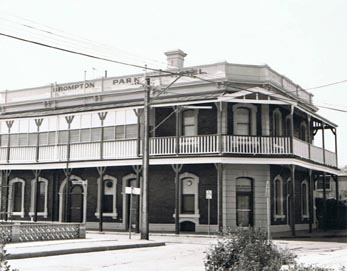 |
THE BROMPTON PARK HOTEL stood on the corner of First Street and Coglin Street in Brompton. It was a popular drinking spot for those who had a few shillings to spare to buy a drink, particularly on a Saturday afternoon. My father, Leonard Colwell, although a strict teetotaller, played the piano in the back bar to earn a few shillings.
|
||
| FULL DAYS AND PRESSED PANTS
|
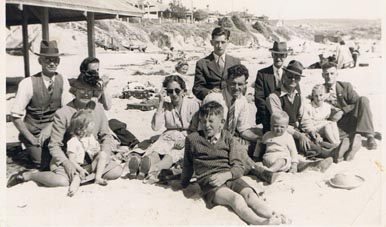 THE GROCERS’ PICNIC, which is described in Full Days and Pressed Pants, was usually held on a Saturday morning at a local beach. Storemen in wholesale grocery warehouses worked 44 hours per week, four hours of which were worked on Saturday mornings. When lads like Mike started working at fourteen years of age there were no paid annual holidays; only Easter, Christmas and other public holidays were allowed. The author is centre back. |
|
||
|
GLORIOUS DAYS AND KHAKI PANTS |
||
|
|
||
|
Bandiana Ordnance Camp; The setting for Glorious Days and Khaki Pants.
|
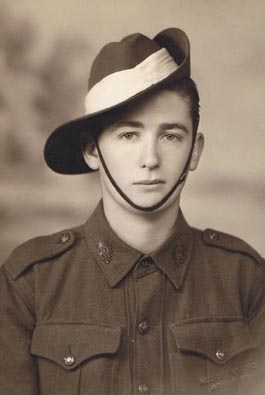 |
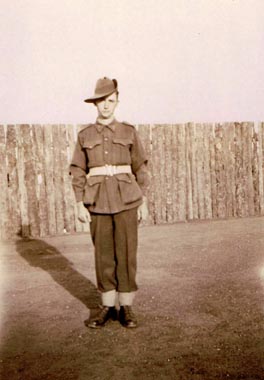 |
|
|||
|
During the war years, 1939 to 1945, conscription was brought in and all physically fit boys of eighteen years had to perform military service in the army, navy or air force. If a youth volunteered he could be sent to serve overseas, but if he did not he could be made to serve in Australia and parts of New Guinea. These photos of Max Colwell were taken at Cowra in New South Wales where thousands of young men did their army training.
|
|||||
 |
A photo of a group of rookies, as new trainees were called, taken at Cowra in New South Wales. Later they were sent to New Guinea where several were killed or wounded. Siddy was one of those who gave his life in the latter years of the war. Fred and Mike survived to return to Australia.
|
||
|
GREAT AUNT AGNES UNDER CANVAS |
||
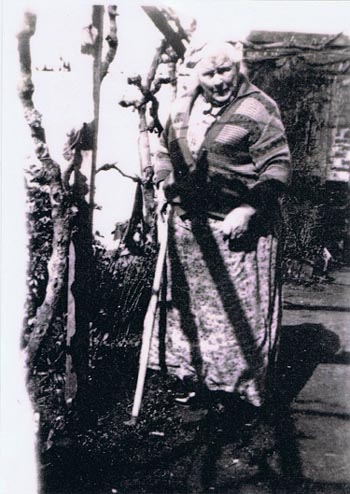 |
Great Aunt Annie Higgs (my grandmother Carroll’s sister) who lived in a tent at the bottom of my grandmother’s garden at 43 Farrant Street Prospect SA for the last twelve years of her life because she thought it was unhealthy to sleep inside. She died in 1932. The character of Great Aunt Agnes Under Canvas was based on my Great Aunt Annie. She was a bad-tempered, rather cranky old lady who believed that small boys should be seen and not heard. On one occasion Keith Smyth, my cousin, and I waited until Great Aunt Annie had settled herself on the outside dunny, then we took a rake and activated the rooftop cistern. Great Aunt Annie appeared with a wet posterior and a look on her face that would frighten a bull terrier.
|
||
|
HOME PAGE MAX COLWELL autobiography PICTURE GALLERY
|
||
| RETURN TO TOP |